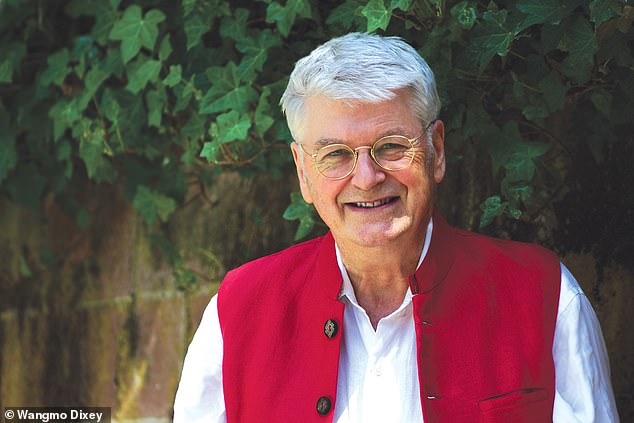I’m a meditation expert and here are the 5 ways you can achieve peace and clarity in just three minutes
Meditation has long been praised for its countless benefits, and there are countless different ways to achieve a peak state of calm..
But what if you don’t have time to think for hours in the abyss of your brain?
One research scientist has revealed how spending just three minutes a day for fourteen weeks can provide lifelong insights and help you achieve balance and wellbeing.
Richard Dixey—who is a Buddhist and divides his time between California and India—has drawn on his own teachings and meditation practices to come up with fourteen simple, short, guided exercises in his new book, Three Minutes a Day.
He told FEMAIL that these methods will clear your mind, relieve stress, sharpen your thinking, improve concentration and increase creativity.
Richard Dixey – who is a Buddhist and divides his time between California and India – told FEMAIL how spending just three minutes a day for fourteen weeks can unlock lifelong insights and help you achieve balance and wellbeing. Stock image used
The expert revealed that the key is ‘concentrated repetition’ – which then turns a practice into a habit.
“Meditation is unusual because it is essentially a non-doing, a relaxation in cognitive clarity that is already present,” he explained.
“To start, it’s helpful to know what you’re doing and why, and then develop a habit that’s easy to start and maintain.”
Richard also shared a tip on how to trick your brain into feeling happier when we start the exercise.
“When we let a faint smile play across our lips, a sense of well-being automatically arises,” he said.
“So smile when you meditate, because it will make your meditation easier and effortless!”
Here, Richard has shared five different ways you can achieve clarity and peace of mind – in just three minutes a day.

Richard has drawn on his own teachings and meditation practice to come up with 14 simple, short, guided exercises in his new book, Three Minutes a Day
1. THE CANDLE MEDITATION
Richard explained, “Choose a candle you like and light it. Place it about six inches away.
‘Find a quiet and comfortable place to sit. A straight back is good so that you stand stable and do not lean one way or another.
‘Let your gaze rest on the flame. Every time your concentration wanders, bring it back to the flame.
‘By doing this you gradually train your attentional faculty and tell it to rest on this object.
“If a thought arises or a sound distracts you, simply return and focus your attention on the flame.”
2. THE FADING BELL MEDITATION
He said, ‘Take a bell or a gong, strike it and then concentrate on the dying sound. (If you don’t have a bell, use an Internet recording.)
“Stay with the sound as it fades away and then sit in silence until you are distracted. Then press the bell or play the sound again.
‘You’ll end up ringing the bell a few times in three minutes, but as you get used to it you’ll find that you can sit in silence for longer periods of time between the sounds.
3. THE FEELING OF BREATHING MEDITATION
Richard revealed: ‘Find a comfortable and quiet place to sit. Close your eyes and focus on your breathing.
‘After you connect with the sensation of the breath, follow it in and out.
‘Expand your concentration to an ever-widening base of consciousness.
‘Enjoy the feeling of continuous breathing.’
4. THE BALADE MEDITATION
The expert revealed: ‘With eyes open or closed, visualize the tip of your nose as a shiny ball, such as a ping-pong ball, a pebble or a pill.
‘Choose the color of the ball. For example, it may start out white and then turn green or blue. Whatever color you imagine, let it glow bright and radiant.
‘As you exhale, imagine it sliding smoothly away from you, and as you inhale, it comes back to the tip of your nose.
‘Never lose touch with it. But if you lose touch with it, it’s the same story: relax, return to the exercise and start again.’
5. WHITE BUBBLE MEDITATION
Richard continued, “Imagine a bubble in the center of your chest. It is soft white, just like a low wattage light bulb.
‘When you inhale, it expands slightly, and when you exhale, it shrinks back to its original size. As you inhale for the second time it grows and envelops you on all sides, and as you exhale it shrinks back to a small bubble in your center.
‘Imagine the bubble expanding with each breath, reaching to the walls of the room and then back again, then to the edge of your house and back again, as you breathe in and out. Take as many breaths as you like between size increases.
‘Let it grow bigger and bigger, spreading to the edge of your garden, to the center of your town or city, then to the city, then to the capital of your country, and so on, shrinking back again and again into your chest as you exhale . Until it finally encompasses the entire universe.
‘After it encompasses the universe, you successively contract it again, expanding a little less with each breath, until finally it rests like a white bubble in your chest.
‘Let it stay there, the bubble glows a little brighter as you inhale, but remains the same size.’
